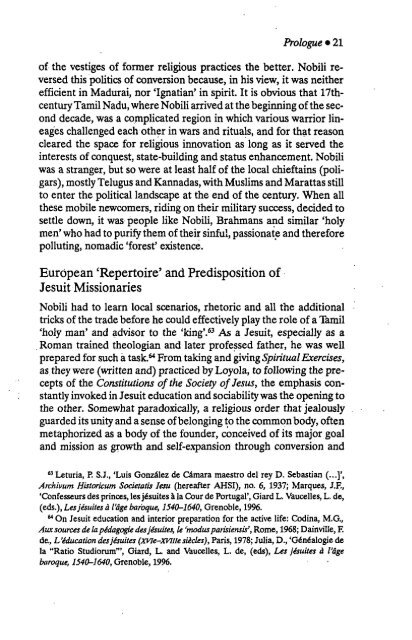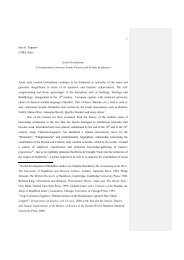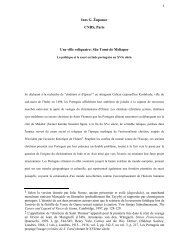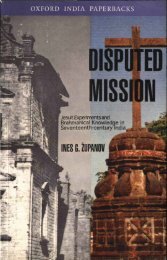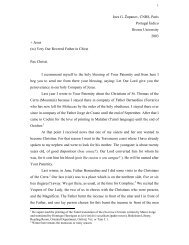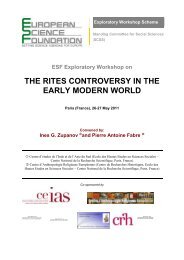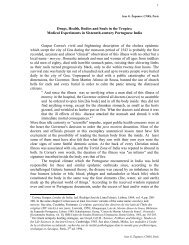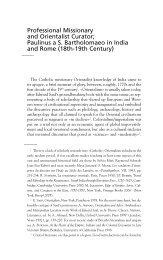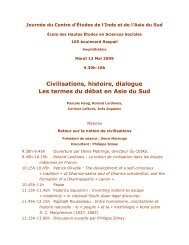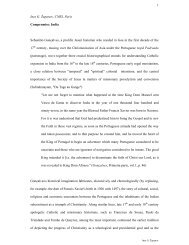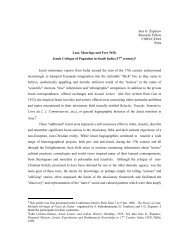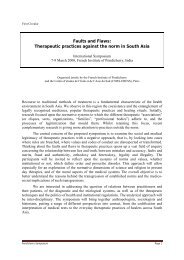INES G. ZUPANOV - Ines G. Županov
INES G. ZUPANOV - Ines G. Županov
INES G. ZUPANOV - Ines G. Županov
You also want an ePaper? Increase the reach of your titles
YUMPU automatically turns print PDFs into web optimized ePapers that Google loves.
Prologue • 21<br />
of the vestiges of former religious practices the better. Nobili reversed<br />
this politics of conversion because, in his view, it was neither<br />
efficient in Madurai, nor 'Ignatian' in spirit. It is obvious that 17thcentury<br />
Tamil Nadu, where Nobili arrived at the beginning of the second<br />
decade, was a complicated region in which various warrior lineages<br />
challenged each other in wars and rituals, and for that reason<br />
cleared the space for religious innovation as long as it served the<br />
interests of conquest, state-building and status enhancement. Nobili<br />
was a stranger, but so were at least half of the local chieftains (poligars),<br />
mostly Telugus and Kannadas, with Muslims and Marattas still<br />
to enter the political landscape at the end of the century. When all<br />
these mobile newcomers, riding on their military success, decided to<br />
settle down, it was people like Nobili, Brahmans and similar 'holy<br />
men' who had to purify them of their sinful, passionate and therefore<br />
polluting, nomadic 'forest' existence.<br />
European 'Repertoire' and Predisposition of<br />
Jesuit Missionaries<br />
Nobili had to learn local scenarios, rhetoric and all the additional<br />
tricks of the trade before he could effectively play the role of a Tamil<br />
'holy man' and advisor to the 'king'. 63 As a Jesuit, especially as a<br />
Roman trained theologian and later professed father, he was well<br />
prepared for such a task. 64 From taking and giving Spiritual Exercises,<br />
as they were (written and) practiced by Loyola, to following the precepts<br />
of the Constitutions of the Society of Jesus, the emphasis constantly<br />
invoked in Jesuit education and sociability was the opening to<br />
the other. Somewhat paradoxically, a religious order that jealously<br />
guarded its unity and a sense of belonging to the common body, often<br />
metaphorized as a body of the founder, conceived of its major goal<br />
and mission as growth and self-expansion through conversion and<br />
63 Leturia, P. S.J., 'Luis González de Cámara maestro del rey D. Sebastian (...]',<br />
Archivum Historicum Societatis Iesu (hereafter AHSI), no. 6, 1937; Marques, J.F.,<br />
'Confesseurs des princes, les jésuites àia Cour de Portugal', Giard L. Vaucelles, L. de,<br />
(eds.), Les jésuites à l'âge baroque, 1540-1640, Grenoble, 1996.<br />
M On Jesuit education and interior preparation for the active life: Codina, M.G.,<br />
Awe sources de la pédagogie des jésuites, le 'modus parisiensis', Rome, 1968; Dainville, F.<br />
de., L'éducation des jésuites (xvie-xviiie siècles), Paris, 1978; Julia, D., 'Généalogie de<br />
la "Ratio Studiorum"', Giard, L. and Vaucelles, L. de, (eds), Les jésuites à l'âge<br />
baroque, 1540-1640, Grenoble, 1996.


